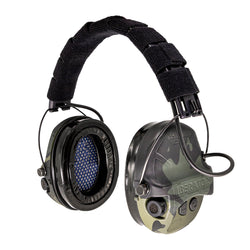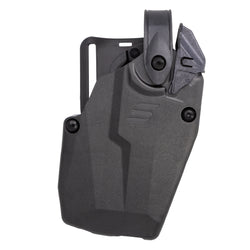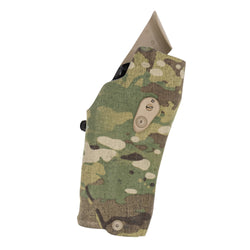Have you ever wondered why someone would take a perfectly good, often expensive, rifle and spray paint it? Questions about camouflage come up frequently, especially when it comes to spray painting your firearm.
For many, a firearm is a big investment, a prized possession, and/or a tool of survival. Most of us grew up learning to take care of our firearms, and painting over one just feels wrong. But like anything, the more you learn about the subject, the more you understand it and why people do it. For hunters, military personnel, and those with survival and self-defense in mind, a standard black rifle can be a liability.
When it comes to guns and “tactical” gear, black is the universal color for being cool. Have you noticed the cool guys in movies always get out of a black SUV wearing their black sunglasses, suits, or tactical clothes and guns?
The only problem is that its sharp, unnatural silhouette stands out against almost any background, making the person easily detectable. This is why so much attention is placed on camouflaging vehicles, clothes, gear, and guns.

I find firearm camouflaging to be a fascinating blend of scientific principles and artistic application. If you need to blend into the dead of night, all-black gear works just fine. But during any other time of day, camouflaging your rifle can make a big difference.
While I often focus on rifles when discussing camouflage, some people choose to camouflage their handguns as well. However, it’s more common with rifles since they stand out more when carried and don’t have a holster to conceal part of them.
Why Camouflage Your Gun?
A solid black rifle presents a distinct, man-made outline that is instantly recognizable. Applying an effective camouflage is not just about matching the colors of the environment. It’s about using patterns to obscure the firearm’s form, making it harder for the human eye to process.
One question that comes up a lot with rifles specifically: Is the camouflage pattern on a rifle you see in a store the same as one designed for real-world effectiveness? Often, the answer is no. Many commercially available “camo” finishes are created more for aesthetic appeal than for practical concealment.

These patterns might look “cool” up close, but can actually be counterproductive in the field. Designs that are too uniform or have small, repetitive patterns can merge into a single, solid color at a distance. This will make your rifle more conspicuous.
A good camouflage prioritizes irregular, multi-scale patterns and colors that are genuinely representative of the environment around you.

There isn’t anything wrong with having a factory camouflage finish for cosmetic purposes if that’s your intent. Just be mindful of the purpose of your rifle.
The Science of Disappearing: More Than Just a Paint Job
The art of camouflage is based on deception and design. Its primary purpose is concealment from an observer. This could be on a hunting trip, the battlefield, in a crowd of people, or any other setting. You want to make an object or person blend with its surroundings so it’s difficult to detect.
To do this, you must trick the human eye and brain’s complex system of pattern recognition and edge detection.
Camouflage works by breaking up the distinct outline of a person or object, a principle known as disruptive coloration. The use of mottled patterns that mimic the environment helps to merge the subject with the background. Mottled patterns are blotches of different colors and shades that do not have a regular design. This is used in combination with background matching.

When the process of countershading (darker colors on top and lighter ones) is used, it counteracts the natural effects of sunlight. Sunlight will typically illuminate the top of an object while leaving a shadow across the bottom. This combination of colors, patterns, and shades disrupts the visual cues our brains rely on to identify shapes and forms. What you end up with is an object or person that does not stand out as easily to the human eye.
A camouflage paint job is not magic and won’t always make an item “disappear” completely. But the better it blends with the background, the harder it is to see.
In the photos above, you can still see the rifles I have lying on the ground. While you can see them, they do not stand out as much as the solid black rifle.
I have found that choosing the pattern for a camouflage job is harder than choosing the colors. This is something I’m still working on, but it’s a fun process to learn.
The Art of Application: Where Science Meets Skill
Having the most scientifically advanced camouflage pattern is useless if it’s applied incorrectly. The application of camouflage is an art of its own that directly impacts its effectiveness.
This is why a lot of people choose to paint their own rifles. It allows them to create a custom pattern perfectly tailored to the specific environments around them. This could be a dense forest, a rocky mountainside, a desert, or more.
The process is far more intricate than simply shaking a can of spray paint. It typically begins with a base coat of a neutral, earth-toned color like flat dark earth or olive drab.

Subsequent layers of other colors are then added. This can include natural stencils like leaves, branches, grass, or even mesh bags. People use anything that helps them create a random, organic pattern. The key is to avoid symmetry and hard edges. Nature is chaotic and imperfect, and an effective camouflage job should reflect that.
Your goal is to create visual “noise” that confuses the eye and prevents the brain from forming a recognizable shape.
I’ll admit this is not an art I have mastered yet. When I practice camouflaging a rifle, I use various tips I’ve learned from others, and I like to try new things. As I mentioned above, this process is much harder than it looks and is often time-consuming.
One thing I’ve found that helps is to practice on a piece of cardboard just to see how the different colors, layers, and shapes are going to turn out. Once you have something you like, give it a try on your rifle.
Does it hurt the gun to spray paint it?
No, spray painting a gun will not hurt its functionality. It may hurt its resale value because it doesn’t have the normal aesthetic. Paint will scratch, fade, and even smudge sometimes.
I can also make a new pristine rifle look like an old worn-out rifle to an untrained eye. A seemingly “messy” paint job on a high-end rifle might actually be the most effective firearm for a specific area.
There are certain things you want to keep spray paint from getting on, like the lens on an optic or scope, inside the barrel, magazine well, and trigger assembly. But paint will not hurt the gun itself or most gear you put on it. You can use painters’ type, masking type, or some other type of tape for those areas you want to protect.
In the photo below, you can see I did not paint the windage and elevation turrets because I didn’t want to cover up the markings on them. I have caps however, that cover them up, and I did paint those (Sorry, I forgot to add them to the photo).

I know people who apply multiple coats of spray paint to their rifles because they travel to different areas. When the paint starts to build up too much, they strip it down, scrub off all the paint, and start over.
In fact, I know a Vietnam veteran who carries a bag of paint cans with his hunting gear. The camouflage on his rifle changes multiple times per year depending on where he goes hunting. I’ve seen his rifle in white, grey, tan, and a mixture of green and brown colors for the woods.
How can you learn to do your own camouflage?
There is a lot of great information out there about how to apply a good camouflage pattern to your rifle. I’ve always been a bit of a trial-and-error person, so I used a less-expensive AR-15 for practice. I picked up a PSA rifle on sale and put a cheaper optic on it so I didn’t have to worry about messing anything up.
My plan is to practice with it until I’m happy with my camouflage patterns. Then, if I ever need to camouflage one of my good rifles, I will have the supplies I need and will be able to do it quickly.

The military spends more time and resources than anyone on developing camouflage patterns for different settings. This gives us a lot of good options when buying clothes and gear. But remember, a custom camo rifle for your environment may not be effective if the rest of your gear doesn’t match.
Adding a custom camouflage to all your gear and clothes is much more work than just the rifle. Because of this, people often choose the closest camouflage pattern for their environment that already exists and go with that. In that case, setting up your rifle to match your other gear may be the best option.
No matter what you choose, the good thing about doing your own camouflage is that you can change it any time you need. All it takes is learning the science behind it and the art of doing it.









